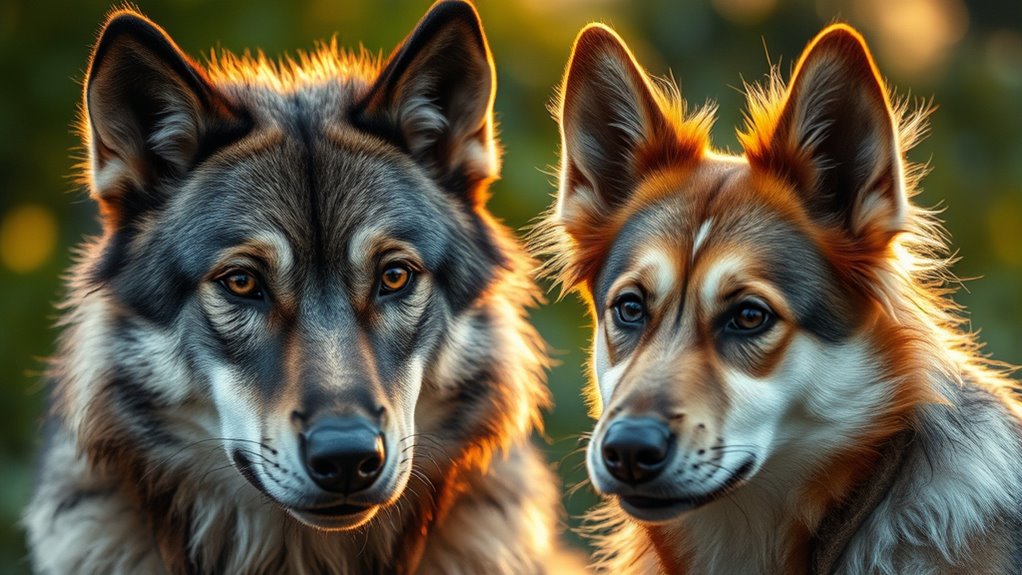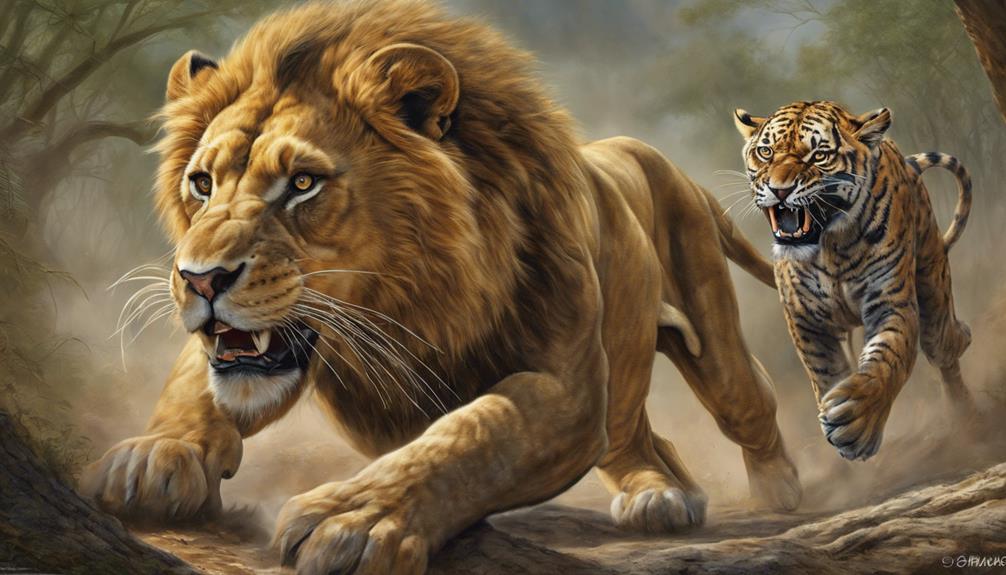Wolves and dogs aren’t the same species, but they’re closely related and share a common ancestor. They belong to the same family and can produce viable offspring. Domestication over thousands of years altered their behaviors and social structures. While wolves are wary and focused on survival, dogs have become loyal companions, seeking human approval. This fascinating divergence shows how environments shape traits. Discover more about their unique characteristics and differences.
Key Takeaways
- Wolves and domestic dogs belong to the same species, Canis lupus, with dogs classified as a subspecies (Canis lupus familiaris).
- They share a common ancestor, having diverged due to domestication over thousands of years.
- Both species can interbreed and produce viable offspring, demonstrating their close genetic relationship.
- Domestication has led to behavioral and social differences, with dogs being more sociable and dependent on humans.
- Despite their shared lineage, wolves maintain wild instincts and social structures, while dogs have adapted to companionship with humans.

Have you ever wondered if wolves and dogs are really the same species? It’s a fascinating question that digs deep into their shared ancestry and the complexities of evolution. While wolves (Canis lupus) and domestic dogs (Canis lupus familiaris) belong to the same family, the differences in their behavior, social structures, and relationships with humans highlight how distinct they’ve become over thousands of years of the domestication process.
Wolves exhibit behaviors driven by survival instincts. They’re natural hunters, relying on their pack dynamics to take down prey. Their communication includes howling, body language, and other vocalizations, which help maintain social order within the pack. If you observe a wolf, you’ll notice its keen awareness of surroundings and ability to adapt to various environments. This wolf behavior stems from its need to thrive in the wild, where every action counts towards survival.
Now, think about your dog. Sure, they share some instincts with wolves, like barking or chasing after a moving object, but their behavior has been profoundly influenced by living alongside humans. The domestication process has altered dogs’ instincts, making them more sociable and less fearful of humans. Unlike their wild counterparts, dogs have evolved to seek companionship and approval from humans, showing a level of dependence that wolves would rarely exhibit.
Interestingly, scientists believe the domestication process began around 20,000 to 40,000 years ago when humans and wolves started forming a mutually beneficial relationship. Humans provided food scraps, while wolves helped control pests and alerted humans to dangers. Over generations, this relationship blossomed, leading to selective breeding for traits that would enhance companionship—traits like friendliness, loyalty, and reduced aggression.
Despite their shared lineage, the divergence between wolves and dogs is significant. While both species can produce viable offspring, the differences in behavior, social structure, and adaptability manifest starkly. You might notice that while a wolf is cautious and wary, your dog is enthusiastic to please and enjoy human interaction. This evolution has led to a world where dogs are often seen as family members, whereas wolves remain wild creatures, embodying the spirit of the untamed. Furthermore, the understanding of AI’s role in behavior can shed light on how different environments may influence the development of specific traits in species over time.
Frequently Asked Questions
Can Wolves and Dogs Interbreed Successfully?
Yes, wolves and dogs can interbreed successfully, creating hybrids known as wolf-dog hybrids. These hybrids often display varying levels of hybrid viability, influenced by factors such as genetics and environment. While reproductive barriers are minimal between the two species, hybrid offspring may face challenges regarding temperament and adaptability. If you’re considering a wolf-dog hybrid, it’s crucial to understand their unique needs and behaviors to guarantee a successful integration into your home.
What Are the Main Differences in Behavior?
Wolves and dogs exhibit distinct behavioral differences. Wolves thrive on pack hierarchy, relying on structured social dynamics for survival. Their hunting strategies are more cooperative, focusing on large prey in the wild. In contrast, dogs often adapt to human environments, displaying varied social structures and less reliance on hunting. You’ll notice dogs are generally more trainable and sociable, while wolves maintain a stronger instinctual drive for independence and territorial behavior.
How Do Domestication Processes Differ?
Imagine you’re scrolling through a history app; you’d see how domestication processes differ dramatically between wolves and dogs. Wolves underwent a slow genetic divergence from their wild ancestors over thousands of years, while dogs followed a more accelerated domestication timeline due to human influence. This led to a variety of traits in dogs that aren’t found in wolves, reflecting their adaptation to living alongside humans rather than surviving in the wild.
What Is the Genetic Similarity Percentage?
Wolves and dogs share about 98.8% of their genetic material, highlighting their close evolutionary relationships. This genetic similarity shows how domestication has influenced their divergence over time. While they have common ancestors, the differences in behavior and physical traits arise from the distinct environments they’ve adapted to. You’ll find that despite their similarities, the genetic divergence reflects the unique paths each has taken through evolution.
How Do Their Social Structures Compare?
Wolves and dogs exhibit distinct social structures. In a wolf pack, you’ll notice a clear pack hierarchy, with an alpha leading the group. They rely on this structure for effective hunting strategies, coordinating as a unit. Dogs, however, tend to have a more flexible social dynamic, often adapting to human leadership rather than a strict hierarchy. While both species share social instincts, their interactions and roles within their groups differ markedly.
Conclusion
So, are wolves and dogs the same species? Well, while they share a common ancestor and have plenty of similarities, they’re classified as different species due to their distinct behaviors and adaptations. Isn’t it fascinating how a playful puppy and a fierce wolf can both trace their lineage back to the same roots? Next time you see a dog wagging its tail, remember it carries a hint of wildness within, connecting you to nature in an unexpected way.









